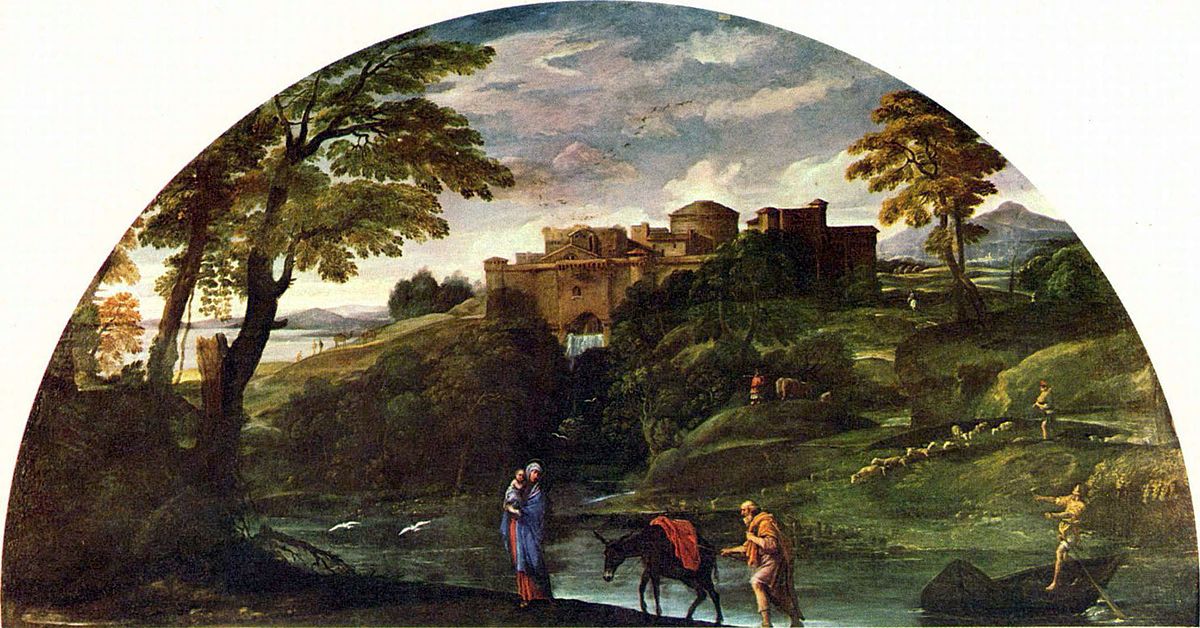
Annibale Carracci, Landscape with the Flight into Egypt, c. 1604, oil on canvas, 122 x 230 cm (Galleria Doria Pamphilj, Rome)
Annibale Carracci’s Landscape with the Flight into Egypt (c. 1604) is regarded as a breakthrough artwork in the genres of landscape and history painting. Carracci’s virtuosic attention to rolling greenery, atmospheric skies, shadowy thickets, majestic architecture, and shimmering water, populated with birds, camels, sheep, cattle and their caretakers envelopes the lunette canvas. The land is sublime and historic, more so than its biblical subject of the holy family. During her fellowship residency at the American Academy in Rome, Devon Dikeou, winner of the Jules Guérin Rome Prize, channeled Carracci’s emphasis on that which is often relegated as “background” or “in-between,” and titled this project “The Inconspicuouses.”
“The Inconspicuouses” is not a single physical artwork, but a conceptual framework for all the artwork she introduced at the Academy—whether it be Ongoing pieces with a 30-year history, collaborative projects, new creations, or ephemeral moments that continue to resonate with time.
Devon Dikeou as Interviewed by Hayley Richardson
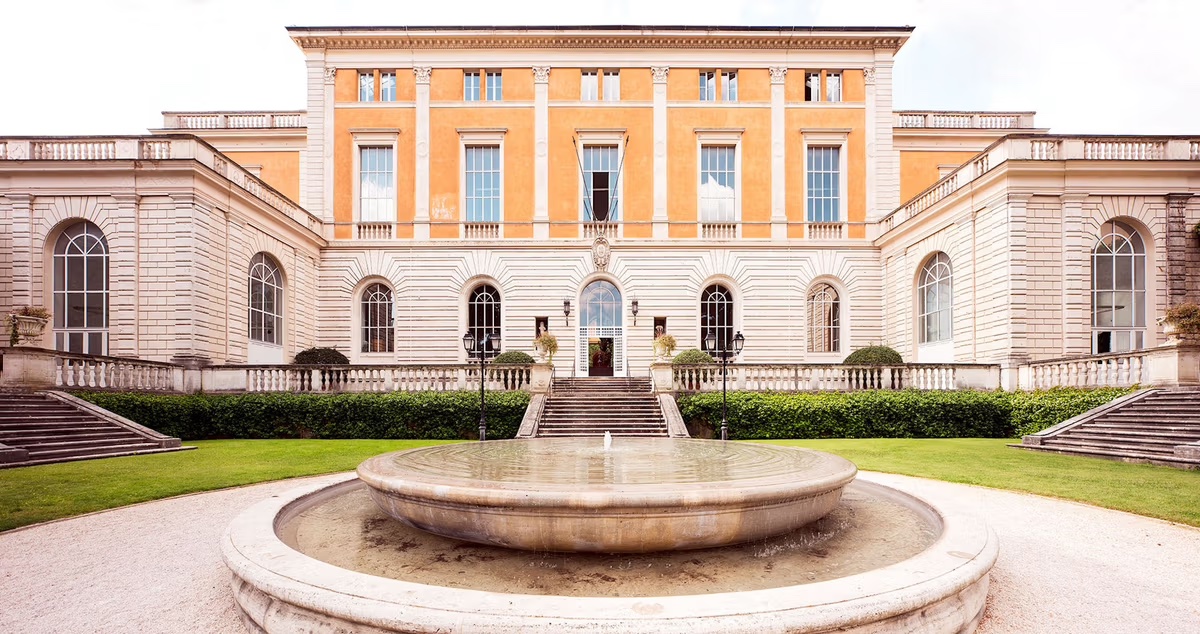
The American Academy in Rome, McKim, Mead and White Building, Photo by altrospazio
As the recipient of the Jules Guérin Rome Prize, you arrived at the American Academy in Rome (AAR) for a 10-month residency in September 2024. What were your initial impressions upon arrival?
Flabbergasted frankly. The history, and the physical presence of the McKim, Mead and White Building changes you. The relevance . . . You feel it even before entering under the watchful eyes of Janus, god of the transitions, endings and beginnings . . . Janus is a symbol of the Academy, proudly yet discreetly displayed above the front entrance. Back to relevance . . . So, the next word that comes to mind is adjustment. Adjusting to the building, the people, and of course Rome.
Your Ongoing artworks, like Suck, continued to expand at AAR while you simultaneously conceptualized and executed brand new work. I am curious about the most recent developments in your studio . . . what can you share?
The moment you arrive and get the keys, they (the studios), are overpowering just on scale alone. My studio, 263, the Mr. and Mrs. David Rockefeller studio, has a window that is superbly set in another era, another time—that of McKim, Mead and White and all their glory. The window is a single window made of 12 large panes of glass and stretches vertically, practically to Mount Everest. Through the window the immediate surroundings offer a landscape that includes giant umbrella pines, regal conifers—reaching like fireworks to the sky . . . And what are windows but canvases, and mine is “a readymade” given by McKim, Mead and White, and this formed the genesis of the “The Inconspicuouses,” the title of my Rome Prize project. “The Inconspicuouses” explores the emergence and nature of landscape as a primary subject matter through the lens of Annibale Carracci . . . And this window, with the landscape spilling in, became my canvas into those Carracci gestures and nuances.
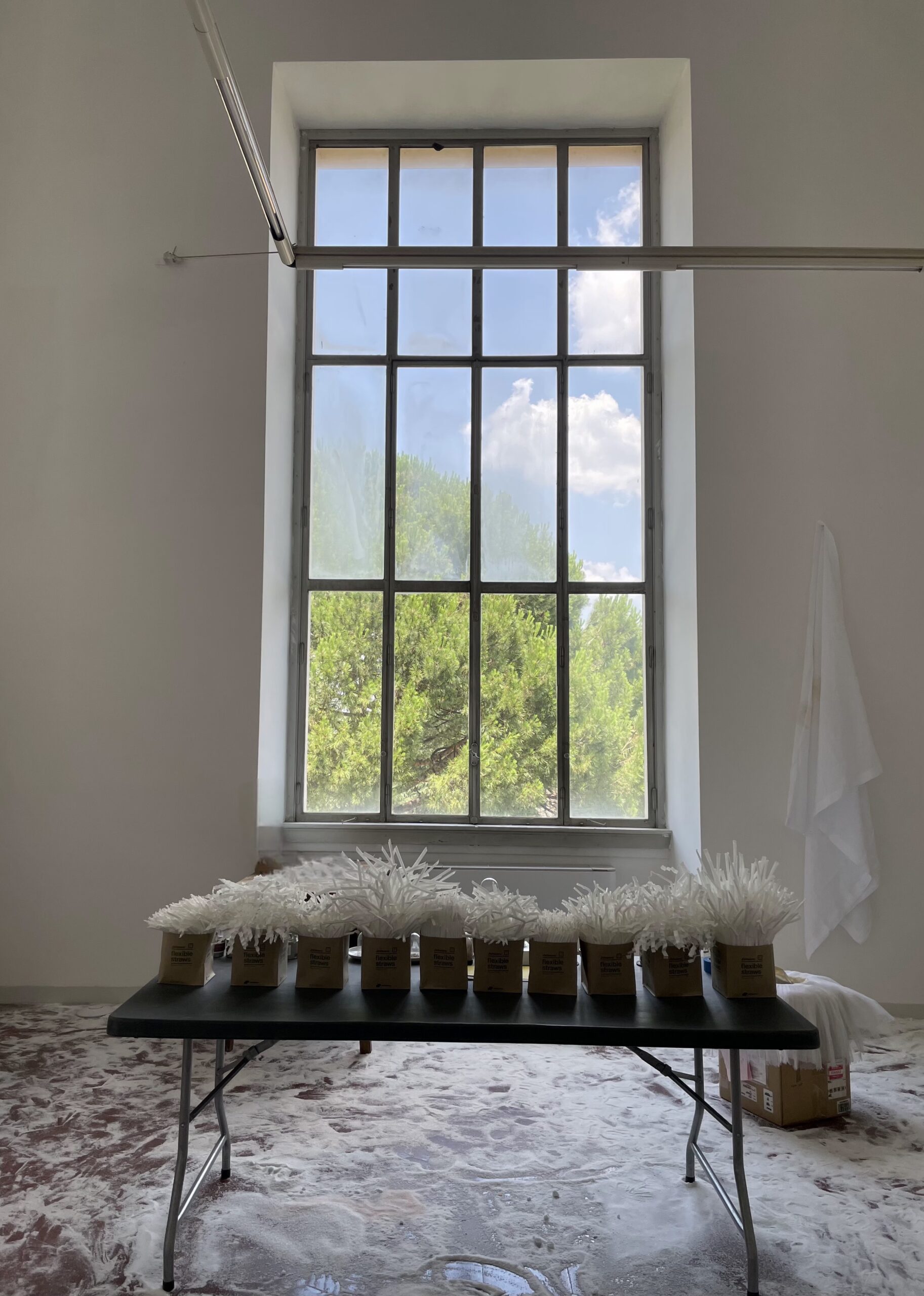
Devon Dikeou, Annibale / Suck, 2024/25 Ongoing / 1991 Ongoing, Live Performance as the Wind Creates Movement with the Umbrella Pine Outside the Window at the American Academy of Rome, Mr and Mrs David Rockefeller Studios, 263 / Live Performance as the Fan Creates Movement with the Straws Made for the Rome Prize
To counter this gigantic window, real and literal, and magically surreal, I eventually came to Stevie and “Landslide.” Supposedly written from a window in Aspen, where Stevie Nicks worked as a domestic, my impulse was to photograph the landscape from the same window that inspired that “landmark” song. But its location is a coveted secret, and unknown, except to Stevie, so I decided to commission Ana, an Aspen domestic, to photograph her idea of a landslide from a window from our home in Aspen . . . Ana’s image, with all its “Star Trek” reflection, was enlarged and printed from the printouts of my AAR “vision board.” It is yet another study in landscape using collage, trompe-l’oeil, and, with a wink to Annibale, to that newly discovered middle ground and landscape as a primary subject matter. And what is landscape as a primary subject matter? Well, my answer became two windows facing off . . . And middle ground, that lovely in-between . . .
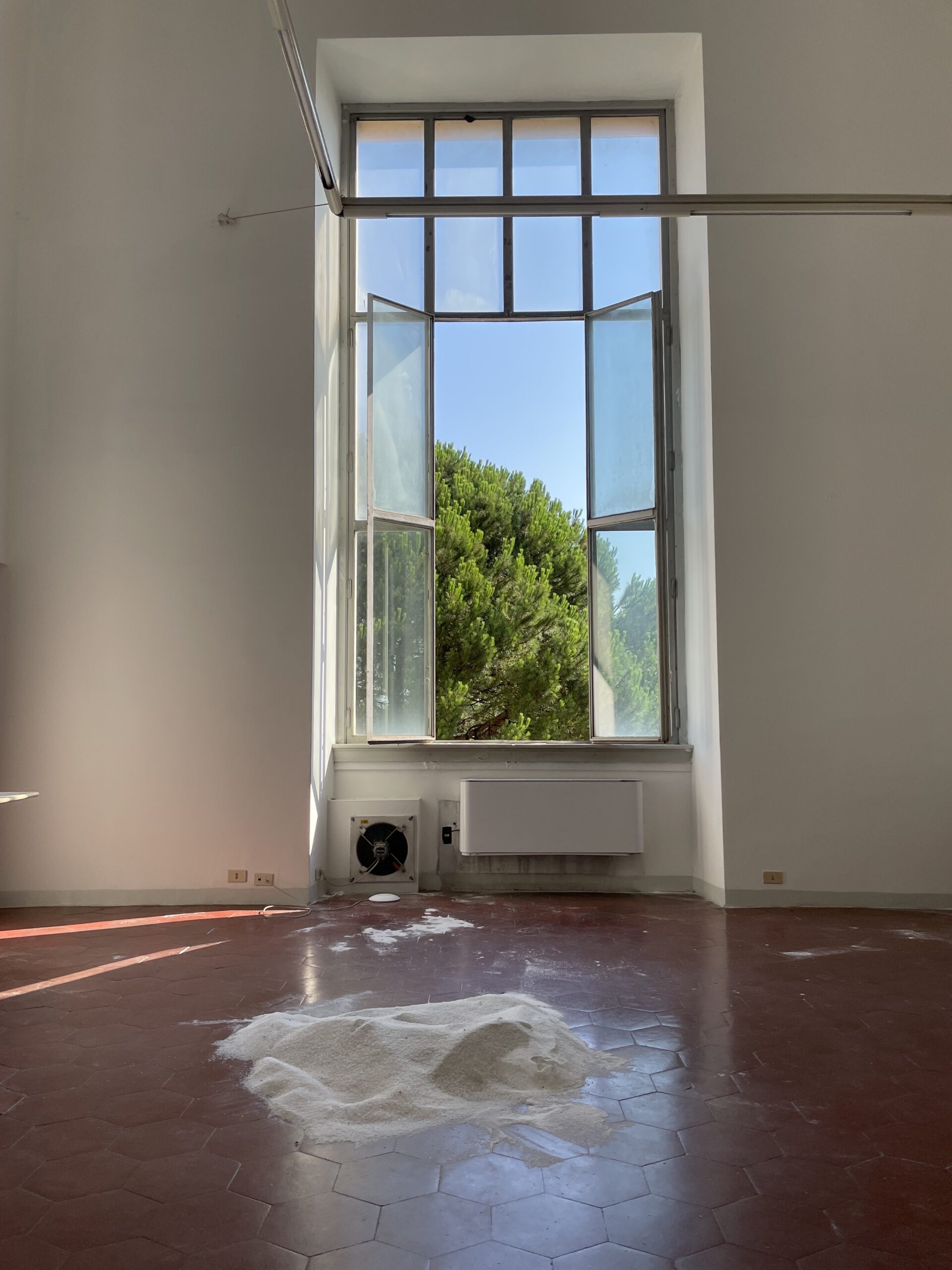
Devon Dikeou, Aspen Snow (Rome Prize), 2024/25 Ongoing, Various Blends of Salt Spread over McKim, Mead White Building Floor at The American Academy in Rome and the Tracks of Viewers
I affirm, and continue to argue, landscape can be anything . . . And I tried to make anything . . . Anything that could bridge these two canvases, two windows, two views, including a bunch of straws (Suck), an Ongoing piece of mine since 1991, that exists as a series of straw bouquets, usually used, but not in this edition . . . Straws can desolate our landscapes/oceans/planet, but here they just shimmer and shake against the mighty pine fluttering its way to majesty in the temporal wind. Look the other way towards the Aspen window for a landscape of another kind . . . No pleached elegance, but a futon covered in airplane blankets snagged by AAR Fellows and their Fellow Travelers, and visiting friends . . . It’s called Red Eye and rests underneath the Aspen window. And then there is the salt . . . decidedly spread all over the studio floor in mounds, in spatters, in the way perhaps snow looks and sometimes feels, and contrasts with the red terracotta floor, while the white artificial weather is a stand-in for Aspen snow . . . Funny, you put salt down to melt snow . . . It does look like a first snow on Main St or simultaneously the remaining days of Carthage . . .
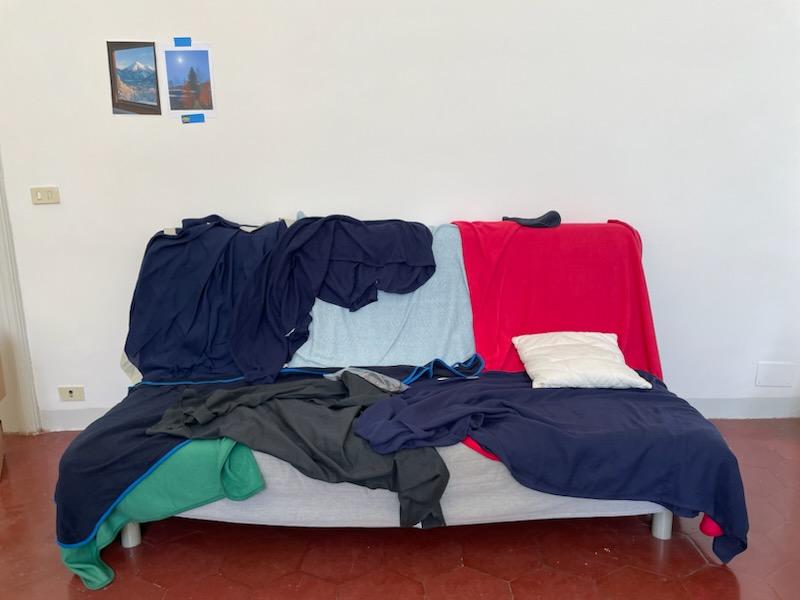
Devon Dikeou, Red Eye (Rome Prize), 2024/2025 Ongoing, Airplane Blankets from Lufsthansa, United, American, Delta, Air Canada, and Latam, Collected by Fellows and Fellow Travelers on Transatlantic Flights
A reoccurring element of your practice is allowing your work to permeate beyond a prescribed exhibition space, like placing installations outside the booth at an art fair or utilizing unconventional settings like offices, parking lots, or retail spaces. What kind of activations occurred outside of your studio during your residency?
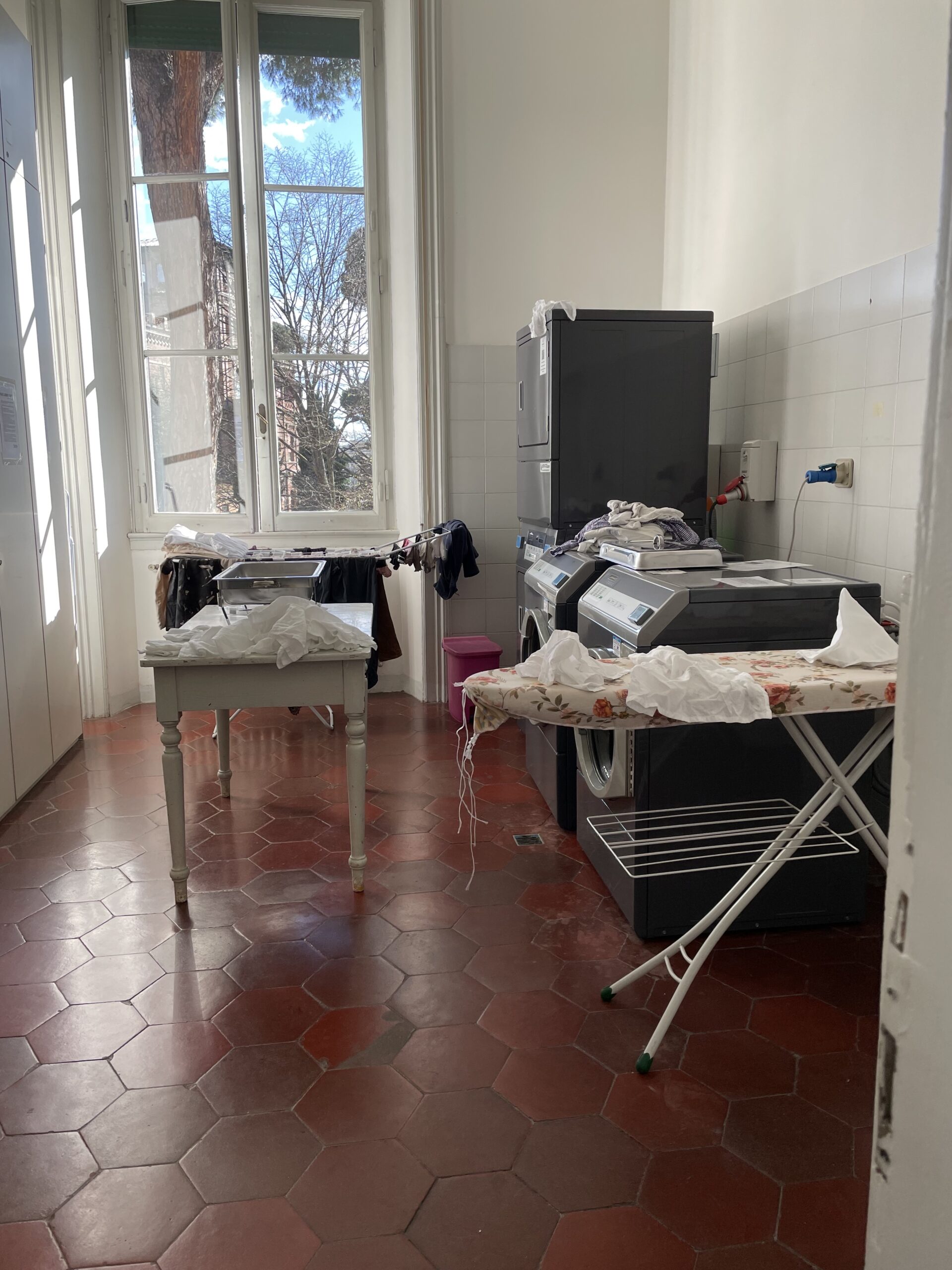
Devon Dikeou, “Out, out damn spot” – Macbeth, Shakespeare (Rome Prize), 1992 Ongoing, Happening: 300 Warm Towels Served to Viewers, Who Enjoyed, Used, and Discarded Towels, Relic of Happening, Variable Dimensions
Well, I’m not a typical studio artist. It took a while to get used to my new surroundings, but a typical studio visit with me explores my surroundings, most likely my home, and the Academy was my surroundings/home. Soooooo the vehicle for that was the McKim, Mead and White Building, often through interventions, like Out, Out, Damn Spot in the laundry room, Hot, Shake and One Little Piggy in the communal kitchen, Suggestion Cards with a prompt to drop the card in the Suggestion Box, (which is right next to the mail boxes), to Pay What You Wish but You Must Pay Something, the donation box series originally exhibited at NADA Miami in 2014/currently on view at the Dikeou Collection in which 20 American museum institutions (so far) have participated. Each museum provided schematic plans of their donation box for replication and visitors make voluntary cash donations. The money is documented and forwarded to the institutions. The donation box was not realized at AAR.
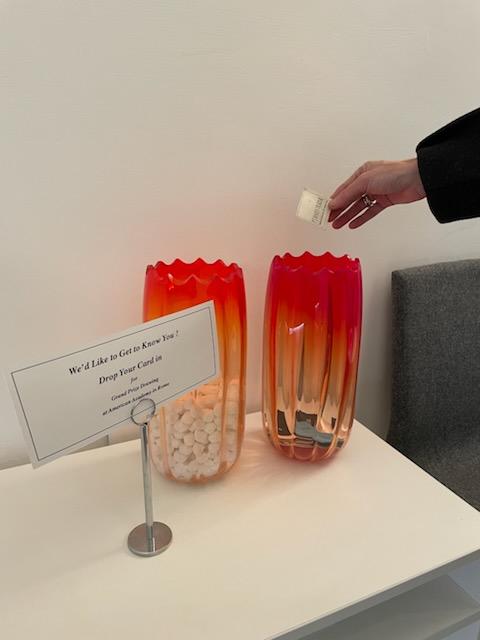
Devon Dikeou, We’d Like to Get to Know You (Rome Prize), 1991 Ongoing, Salviatti Vases, Placard Querying Viewer’s for Business Cards with the Potential to Win Prize, After Dinner Mints, Viewer’s Business Cards
Plus, We’d Like to Get to Know You, placed in the Residential Life Office. Eventually, the lovely Titziana, one of a few who kept us caffeinated and more, picked the Grand Prize Winner out of all the business cards deposited into the American roadside tradition that was gussied up AAR style. The business card picked by Titziana from the Salviati vases belonged to AAR’s Arts Director, Ilaria Puri Purini’s, daughter. Is the fix in . . .
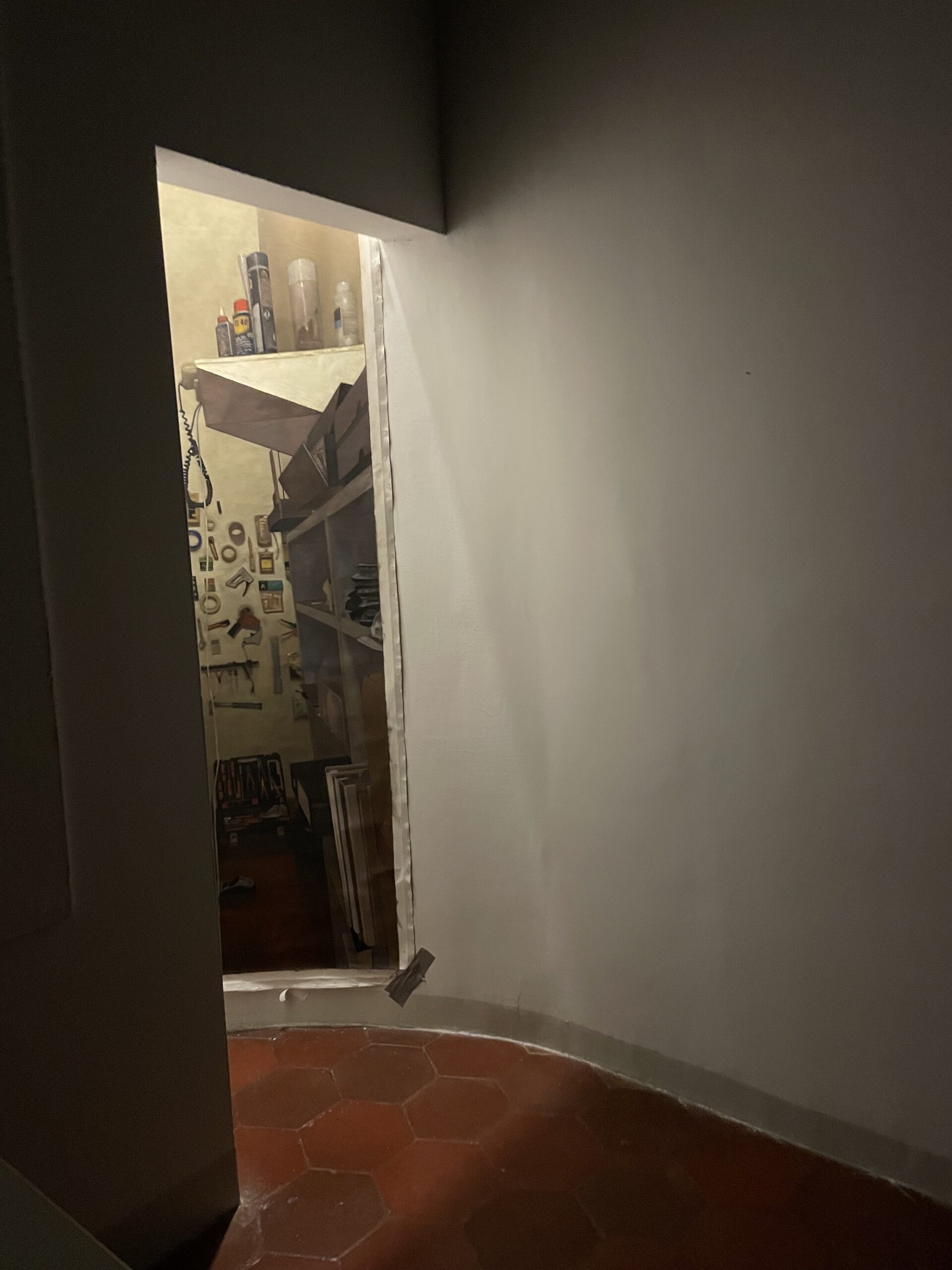
Devon Dikeou, Contrivance: Rome Prize, 2017 Ongoing, Oil Painting on Canvas of Tool Room in David Rockefeller Studio, 263, Rome, Dimensions Variable
Of course, the newest additions of The Niney Timeline, which chronicles the life and times of my security blanket, Niney, as she traverses the art world, including the McKim, Mead and White Building, while resting comfortably in her bedroom/our residence. A toilet paper piece, Entertaining is Fun, installed on the wall with toilet plungers in the WC. There’s Contrivance, a series of photo-realistic paintings of the tool rooms of the various non-studios I’ve had, including at other art residencies. It is a nod to the studio—an intervention that adds to the cycle. My AAR tool room was in the closet of my McKim, Mead and White Building studio. I displayed the photo-realist painting opposite the actual tool room in the nave of the entry, peeking out into the world of in-between windows and lands . . .
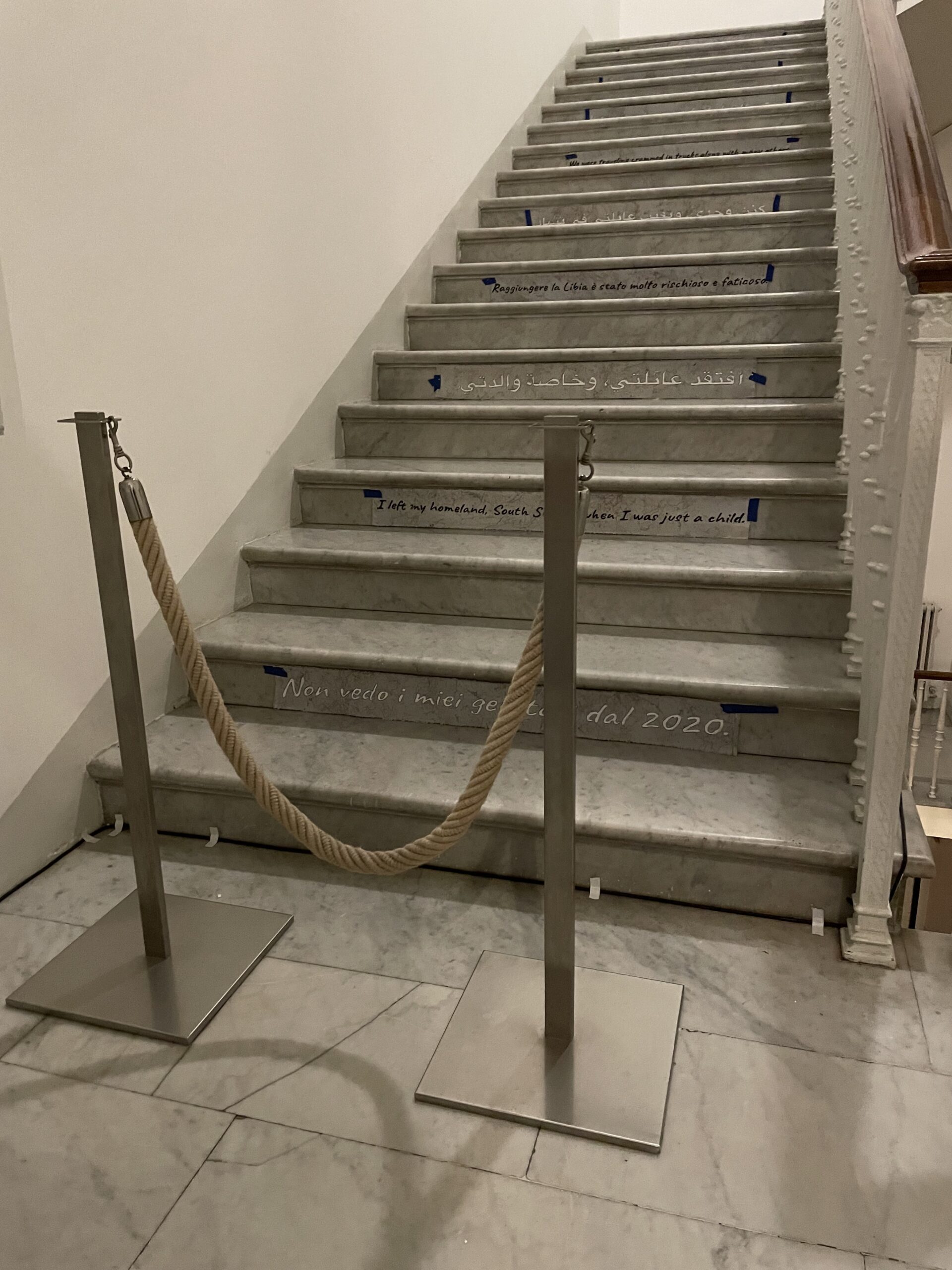
Devon Dikeou, Velvet rope (Rome Prize), 2024/25 Ongoing, Dimensions Variable
And lastly, Velvet Rope, in which I used the AAR rope stanchion placed at the foot of the staircase—meant to keep those deemed “not worthy” away from private areas of the Academy. I acted as bouncer . . . And I let everyone in, one by one, marking them with a Sharpie, just like they were getting into Studio 54, Palladium, the World, Area, or even the Academy. It’s a very exclusive club . . .
One of the most enriching aspects of residencies is the opportunity to collaborate with fellow residents, as well as with locals in the community. What kinds of collaborations were you able to partake in at AAR?
Julia Rose Katz, awarded the Anthony M. Clark Rome Prize, (Circe’s Wand: Reimagining Antiquities in Early Modern Europe) and I were paired for ShopTalks—an AAR program which typically pairs a visual artist with a scholar to make a joint presentation based on their projects/practices and talk about the cross-pollinating that might happen . . . (This program is not open to the public). We decided to not only make a presentation of both our practices, but also, in a unique manner, to make/do something that eventually could be shared with the public, challenging the traditional lecture model. I presented in the form of a studio visit that encompassed the McKim, Mead and White Building. Julia explored her study of how early Modern artists and restorers creatively reimagined damaged ancient sculptures, and how her personal affliction on her leg has influenced her vision towards study and life with regards to film, classical sculpture, modern presentations of sculpture, installations, fashion, semiotics, bricolage etc. The platform of our collaboration is a book . . . We combined our shared interests, and each chose approximately half the images and published a limited-edition run under zingmagazine books. Permanent Accident was the result.
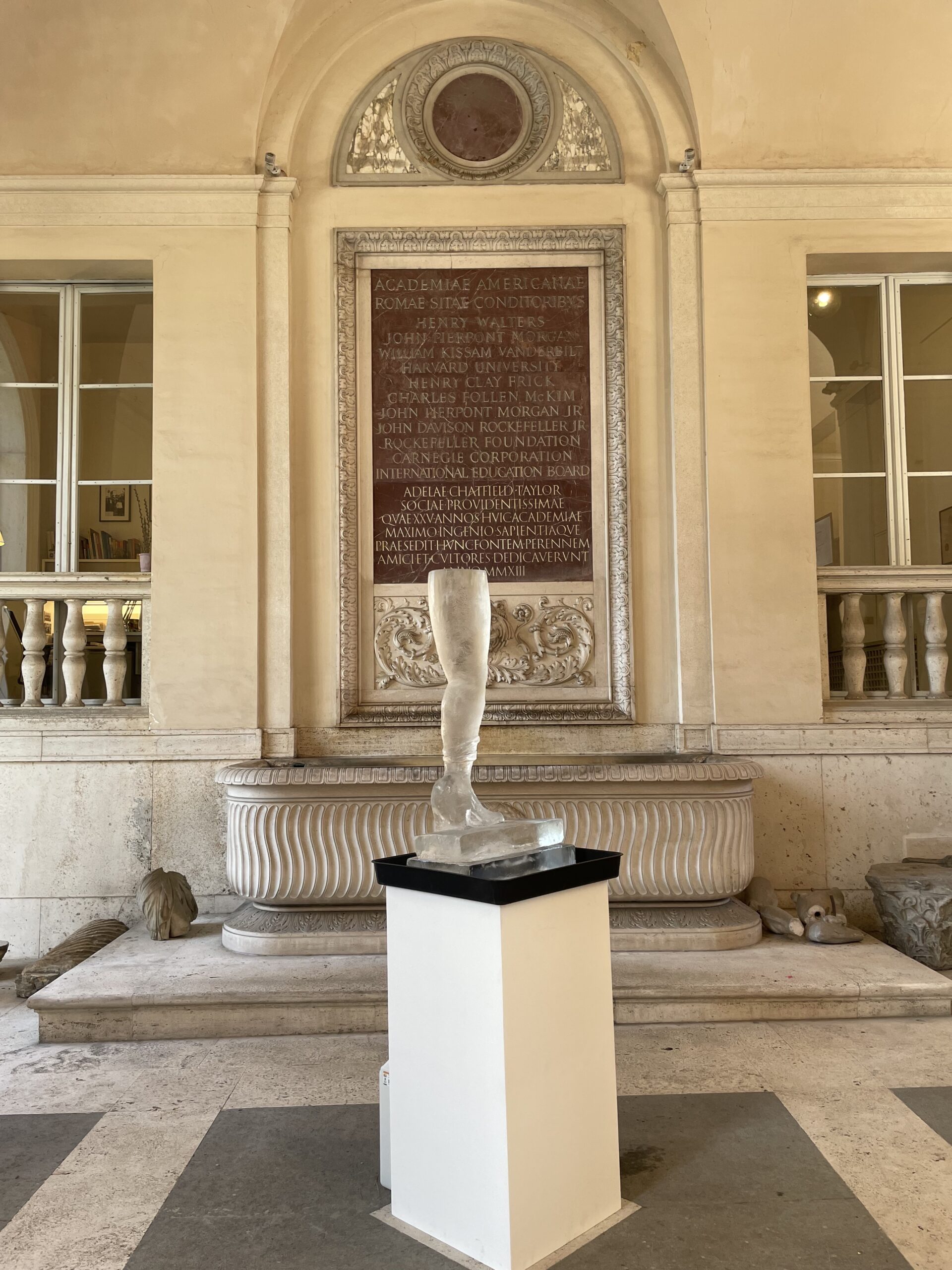
Lizzi Bougatsos, Self-Portrait, 2012, Ice, Artwork curation by Devon Dikeou and Julia Rose Katz at American Academy in Rome, March 2025
Further, drawing from our unique position as curators, Julia and I decided to raid Dikeou Collection and recreate a wonderful installation in the foyer of the Academy where much of the Archeological work was happening—with all the fragments and fountains and study tools . . . There, a leg in the form of an ice sculpture by Lizzi Bougatsos entitled Self-Portrait stood tall and wildly clear in its medium. An inherent vice by nature, the ice glowed among treasures from the ancient world, still giving and sharing their secrets. Self-Portrait is both a sculpture and a performance, which lasts about fours hours as the ice melts and eventually collapses on itself, culminating with the destruction of the leg, because that inherent vice would be painfully bad for the immediate surroundings. Julia did the honors.
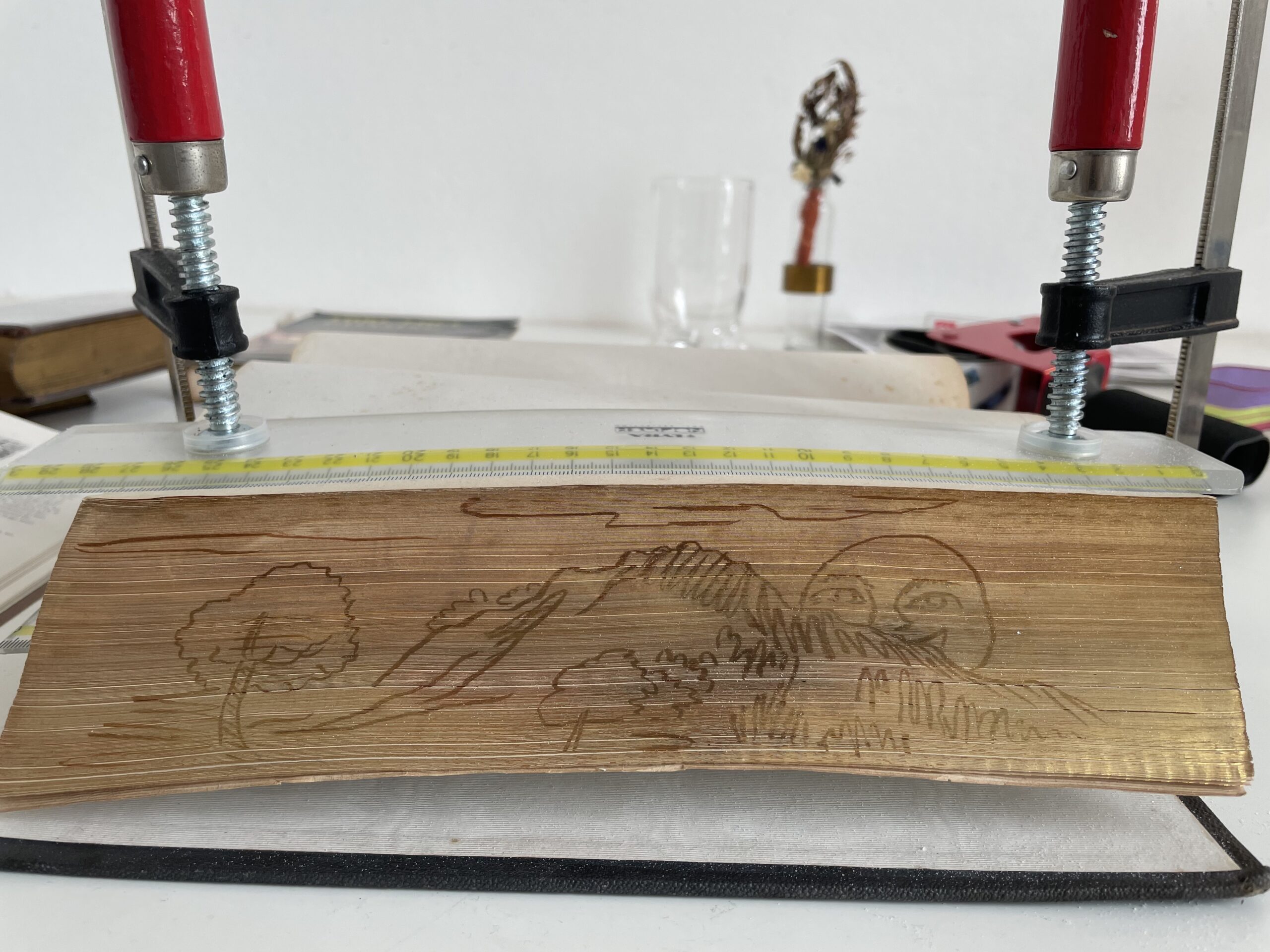
Katherine Beaty and Devon Dikeou, Fore-edged book, after Annibale Carracci, 2024/25
I also collaborated with Katherine Beaty, winner of the Suzanne Deal Booth Rome Prize (A Technical Study of Italian Archival Bookbindings). Together we created a fore-edge book, which are usually insignificant titles but with a gold edge on the paper . . . Bend and twist the paper of the book and it reveals a genuine treasure, a painting of some sort . . . I happen to have a collection of fore-edge books given to me by my father . . . And thinking about Carracci, I was inspired to paint a sketch of his on the side. Strangely enough, Katherine and I met just before the award announcement ceremony at Carnegie Hall and we spoke about fore-edge books and naturally what our projects might entail . . . I’m not that talented of an artist, but she kept encouraging me . . . I’m a little “grey cell Poirot” type-artist. But eventually, we decided to create a fore-edge book together, with the image by Annibale that I selected and her expertise in all things books, including painting on them. It’s now the very first fore-edge book at the Academy’s library.
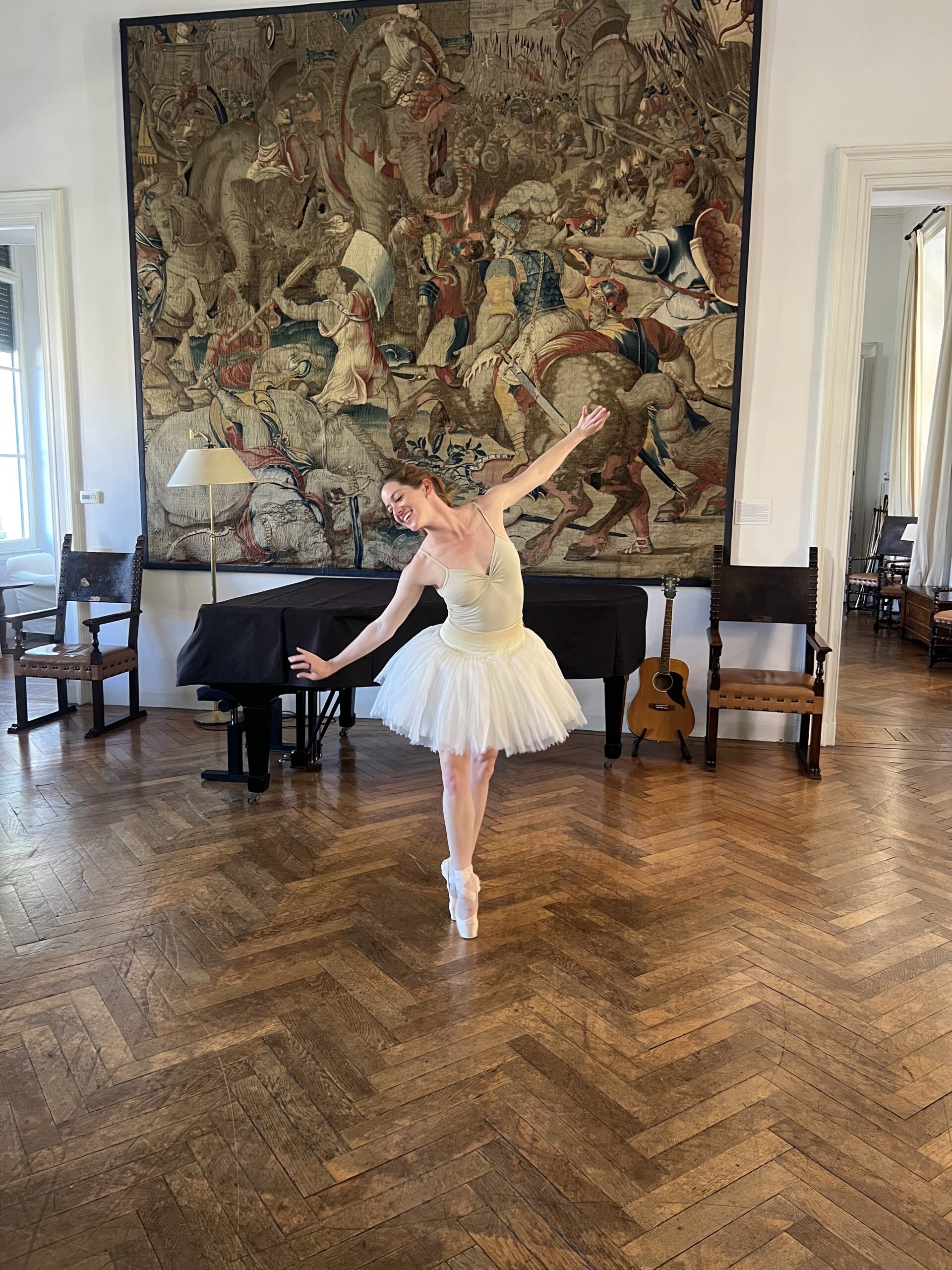
Prima (Rome Prize), 2024/25, Collaboration and Ballet Performance by Prima Ballerina, Holly Dorger, of the Royal Danish Ballet at the American Academy in Rome
Another collaboration was with the prima ballerina, Holly Dorger, of the Royal Danish Ballet. When she visited the Academy, I invited her to do a pirouette and a leap. What she did was a wonderful improvisational performance that ended with me asking for just a bit more, that fantastic leap, all the while Bea, an intern at the Rome Sustainable Food Project, sliced 100 pounds of roast beef on a professional meat slicer, and I made sandwiches for my performance piece, One Little Piggy Ate Roast Beef. I loved sharing dance and food with two other amazing types of creatives . . . It was a great three-way . . . One with someone I just met (Bea) and the other my cousin (Holly), who I know in a forever way.
Shake . . . Ongoing since 1991, the piece is almost improvisational. Moving to NYC, I immediately bought a set of Po-Mo salt & pepper shakers at MoMA . . . They looked good, but they didn’t function. This was followed by another purchase on Bowery—Wayne Thiebaud diner style shakers. Suddenly, I had a collection. Much later the real collection emerged . . . And much, much later for a group exhibition at PS 122–where each artist was given a snow globe as an artistic prompt. My snow globes were recreated into S&P shakers with the actual shakers submerged in the salt and pepper within the snow globe. It is a portrait of friends and travelers over time . . . From the 90s to now . . .
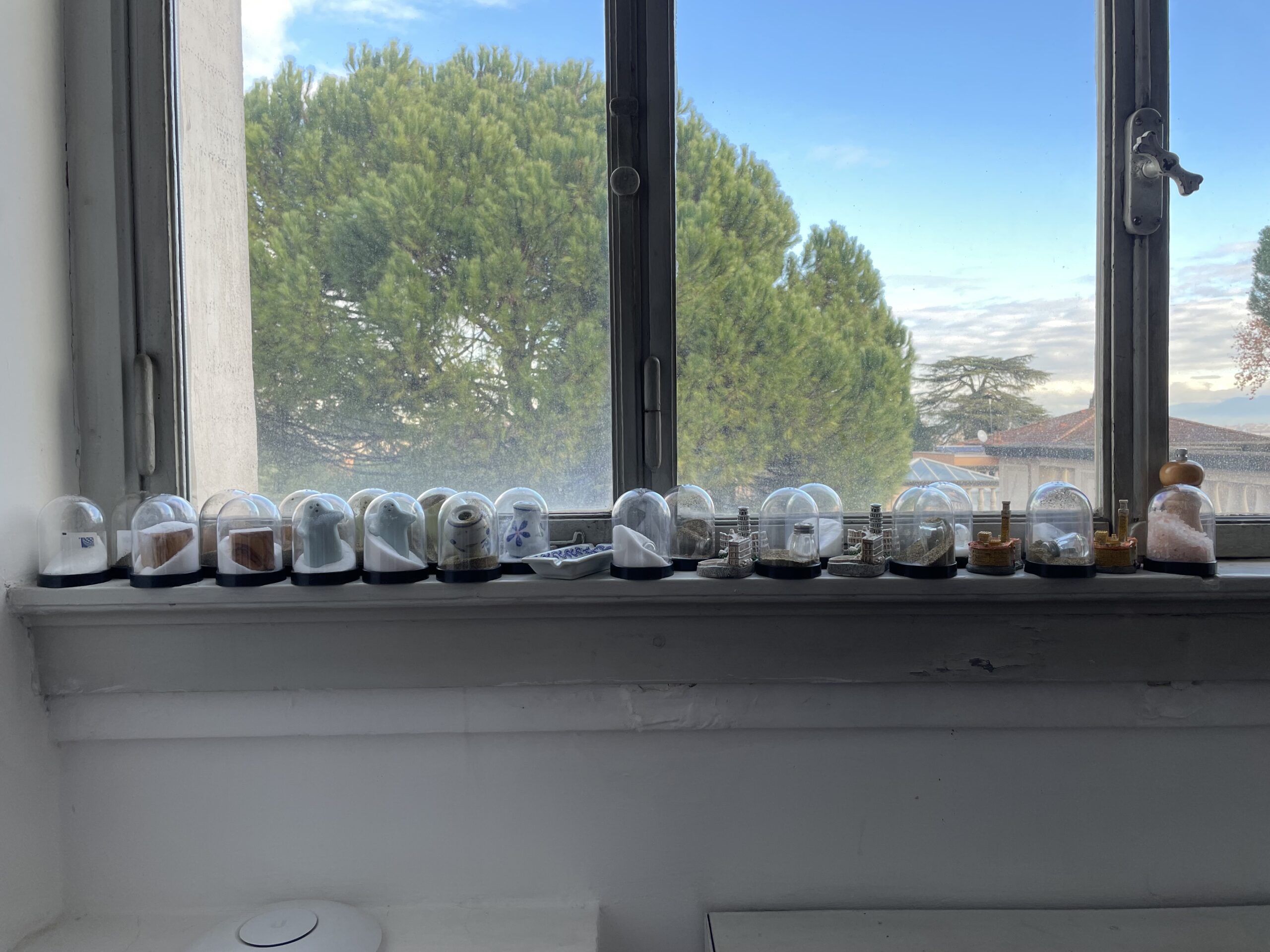
Devon Dikeou, Shake (Rome Prize), 1991 Ongoing, Installation View of Snow Globes Altered to Become Functioning Salt and Pepper Shakers, Each Filled with Salt and Pepper, and when Used, the Diminishing Salt and Pepper Reveals the Actual Accumulated Gift Collection of Shakers, 3 1/2”H x 2 1/2” in Diameter
That gesture was something I felt immediately applicable to the environment at AAR, all the different passions and personalities . . . I realized and felt a group portrait would rock, so I engaged all fellow Scholars and Prize Winners to collaborate in a salt and pepper project. I gave a small stipend to purchase two sets of S&P shakers, and I would create two sets of my ongoing Shake project, one for them as a self-portrait of their time at AAR, and the other which would function as a group portrait of our time at AAR together. Almost everyone participated, but sometimes I found ways for those tardy to the party to represent.
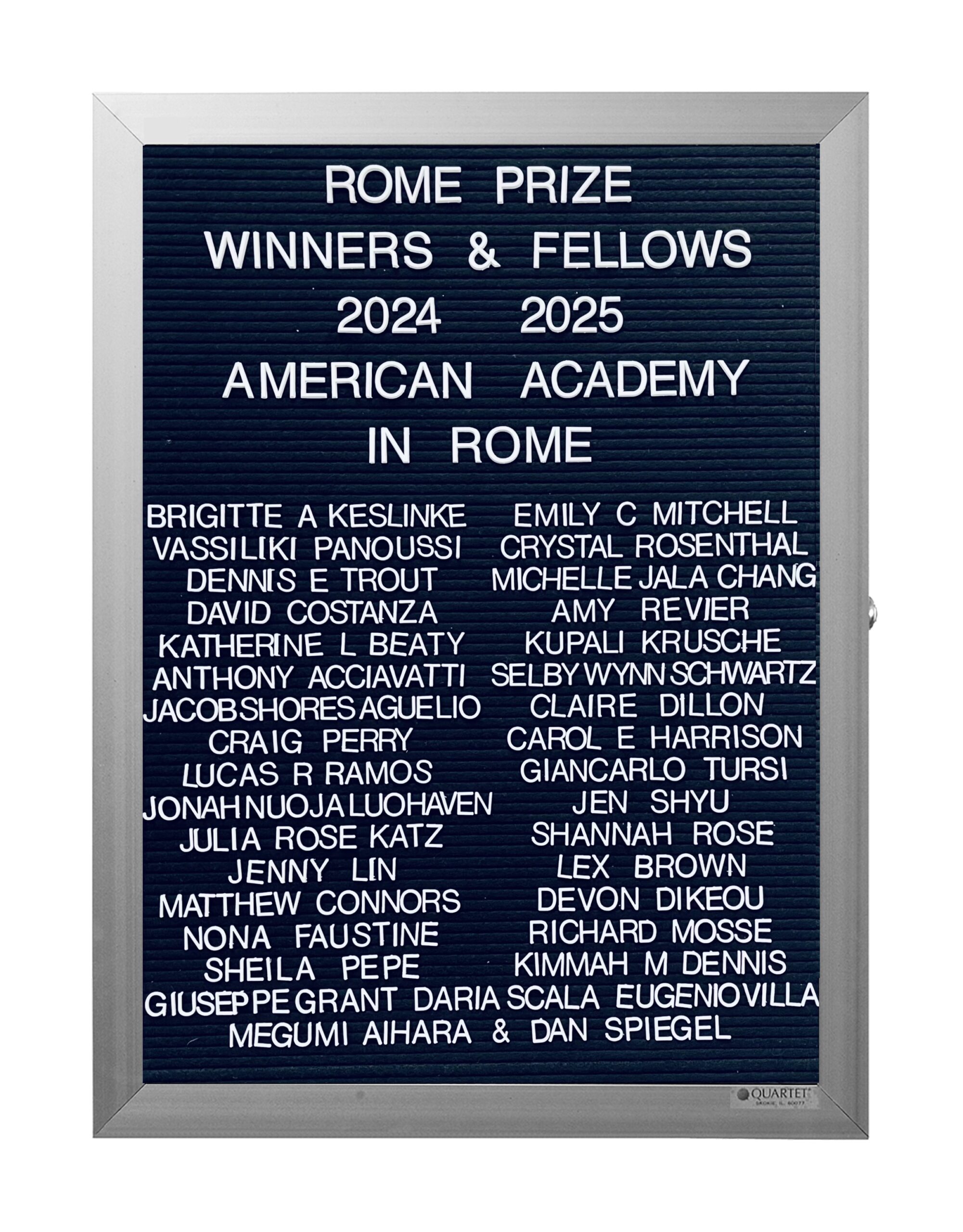
Devon Dikeou, What’s Love Got To Do With It? (Rome Prize), 1991 Ongoing, Rome Prize Winners & Fellows, Lobby Directory Board Listing Artists, Gallery, Curators, Exhibition Titles, Dates Replicating the Lobby Directory Board at 420 West Broadway (Series Initialized for the 1st Group Show in which the Artist Exhibited, and Made for Every Group Show Thereafter), 18” x 24”
Perhaps the longest and most important collaboration, however, began in 1991 with my Ongoing series “What’s Love Got to Do With It?” Inspired both by the Pictures Generation and their use of appropriation and by my aspiration to exhibit in the storied Leo Castelli Gallery, I replicated that equally storied lobby directory board. The one I created sported the names, curators and dates of one of the first group shows in which I participated . . . I realized this board could not be the only one, so I created one for every group show since (about 160 now) plus the table of contents for each issue of zingmagazine, and Dikeou Collection acquisitions. My first proposal as Rome Prize applicant some 15 years ago was to recreate this series for all Rome Prize Winners . . . The first I made was for class of 2024/25. Ongoing . . .
Another new work you realized during your residency blends the myth of Hercules with that of Elsa the lioness from Born Free, creating a completely new narrative about labor, care, conquest, and sacrificial love. Additionally, the presentation of this work at Seconde Vue, a location outside of the Academy, extends our conversation about collaboration and exhibiting art in non-traditional spaces. Who were your collaborators for this new work, both in myth and reality?
One of the goals of the Rome Prize is to embrace an aspect of Rome that will enhance your project. So in my case, “The Inconspicuouses,” it was only natural that I visit the Carracci masterpiece in Palazzo Farnese, aka the French Embassy . . . Naturally, it’s quite an ordeal as it IS a governmental building. But I did manage to visit five times. And the thing about Rome is, it’s full of is all these fabled miscreants and heroes portrayed in statues, frescoes and a plethora of other mediums depicting myths, history, who’s who and more . . . And Farnese adopts both Hercules and Carracci . . . Hercules as a mascot and perhaps Carracci as well. (Notoriously, Carracci is paid a pittance for his exquisite cycle, “The Loves of the Gods,” which includes Hercules). As the myth of Hercules goes, he must complete 12 labors as penance for bad behavior. The first of which is to kill a lioness, which he does with a club. He sports the skin like a Michael Jordan jersey in game two until victory in seven. At the Palazzo there’s a magnificent replica (original in Napoli) of Hercules leaning on his club, skin draped over his shoulder. It’s a great preamble for what’s to come as you tour the Embassy . . . The Carracci cycle—a cycle based on mythological subjects, including Hercules.
But back to the show at Seconde Vue. “The Inconspicuouses” is most decidedly about something Carracci explored outside his work at Farnese, and yet he snuck something in . . . Beautiful snippets of landscape teasing characters in the cycles and the architecture as well. And I very much felt that I’d like to sneak something out of the Academy. And that was an off-site exhibition . . . addressing other aspects of Carracci’s practice and that of my own.
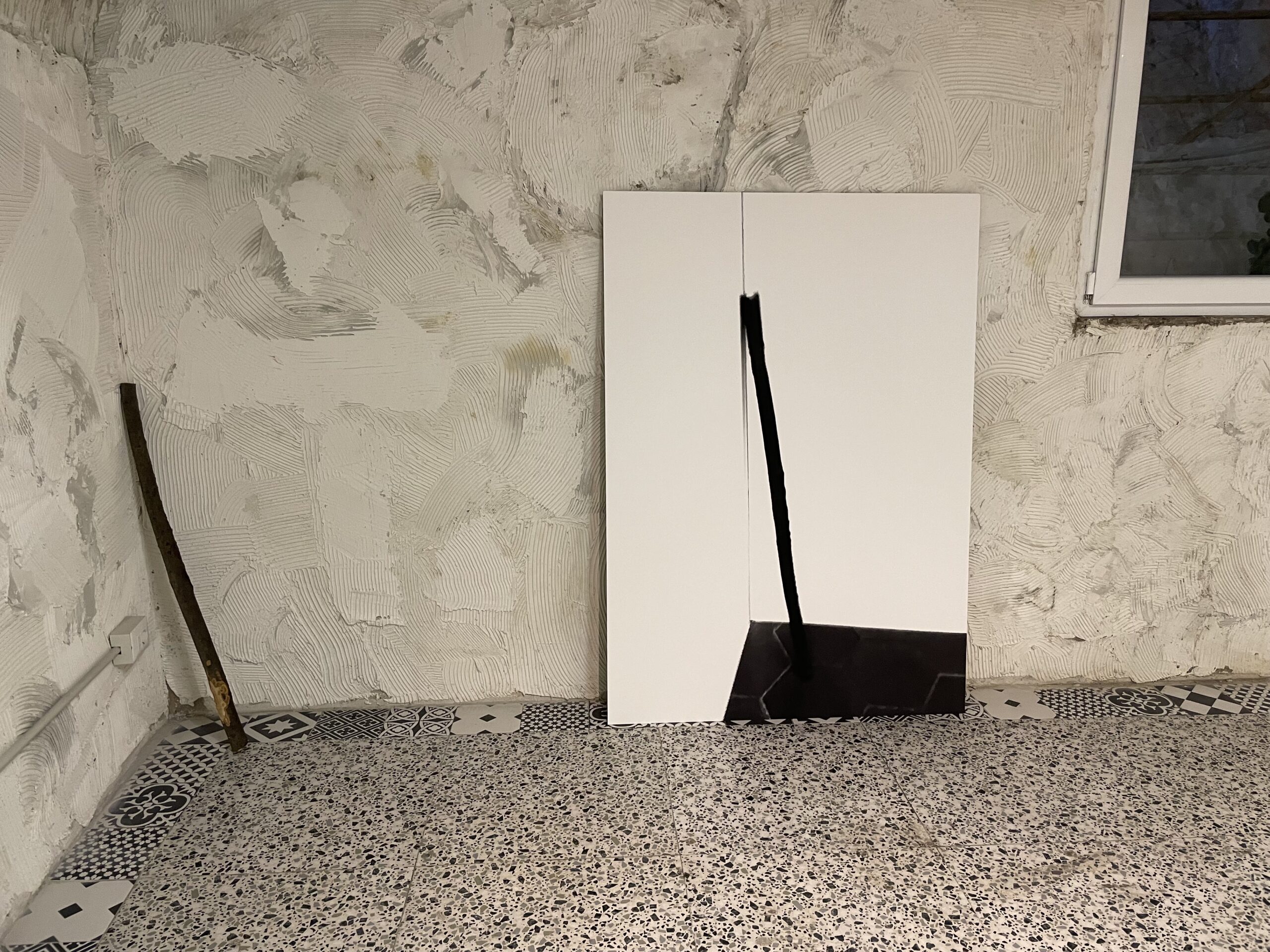
Devon Dikeou, Club, 2025 Ongoing, Found Object from the American Academy in Rome Garden;
Devon Dikeou, Hercules, 2025 Ongoing, C-Print of a Found Object from the American Academy in Rome Garden Positioned to Replicate Ercole Farnese, Farnese Hercules, 3rd Century AD, Club as Leaned on by Hercules Statue Signed by Glykon
The result: “From Fulfillment to Adaptation.” Shown at a Seconde Vue, a concept space by Federica Dollfus Di Volkersberg and curated by Guglielmo Corbo who was introduced to me by a French curator Gèraldine Postel. The exhibition entailed two pieces. A club found by Andrea and Fernando on the Academy campus—ostensibly to fix a sagging clothes rack—but turned out too short for the task. I couldn’t not see it as Hercules’s club, forlorn in the corner, without function. So I adopted it, as I often do, and photographed it—letting the object make the piece, both suture and photograph.
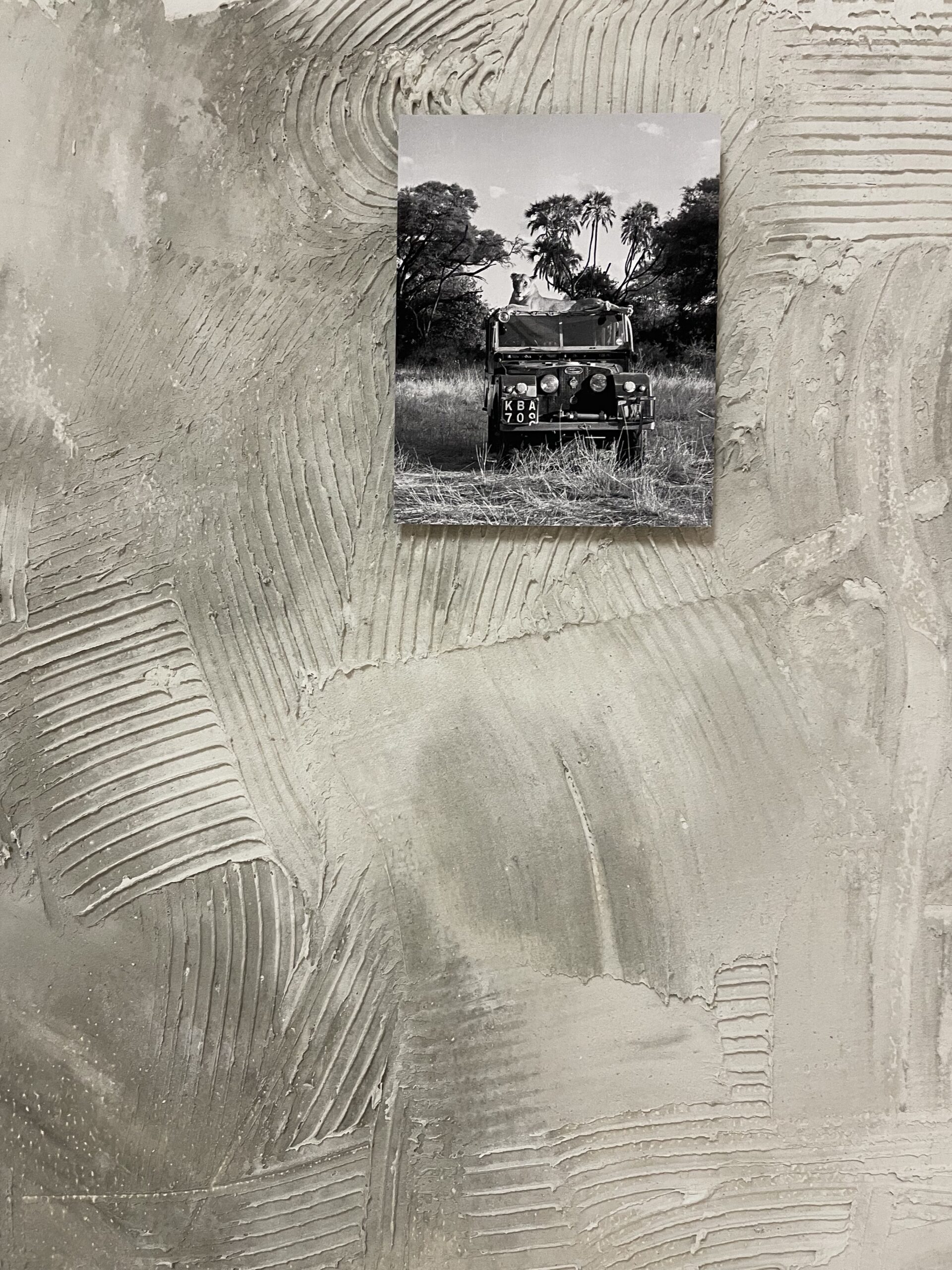
Elsa the lioness of Born Free fame laying on the roof of the Adamson’s Series 1 LandRover, Kenya, 1960, 26.4 x 34.5 cm, © Joy Adamson
But what’s the club without the lioness, and Elsa from Born Free is that, a modern day myth . . . It was a nice contrast to what I was showing at the Academy. Hercules has 12 labors, Elsa one. I love them both for their humility . . . And their spirit. One is born free; one fights to gain that . . . spirit/freedom . . . Or is it the other way around?
Your work as an artist, collector, curator, and publisher/editor is deeply informed by the different platforms in which art is experienced and exchanged, be that between people and/or spaces depending on their respective roles and contexts. Considering the vast size, history, and diversity of Rome and the generous amount of time spent there, did the city itself spark new insight or perspective within this guiding modality of your practice?
Janus. The god of the in-between. Looking both ways, Janus is two faced, not in a catty way, just recognizing the give and take in life and most certainly the creative process. I don’t go to the studio every day . . . And my “practice” traverses lots of different arenas as you mention. Editing/publishing a magazine (which is hosting this very interview), and a collection of contemporary art exhibited in five locations in Downtown Denver, including hosting studio space for the Clyfford Still Museum’s Institute Residential Fellowship Program, as well as my own personal practice. So, I have a lot of chips on the table . . . Hedging this way or that . . . And Rome is a little like that. It’s slow in a way that ancient places are. It gives you insights and glory, little by little. Even when they are the big things . . . Like the Sistine Chapel or the Coliseum, you crawl along and are no different than the pilgrims, tourists, and those just drawn to history and beauty over the years or the locales visited. Which is why the 10-month duration of the residency is essential somehow . . . It used to be longer . . . I wish in a way it was.
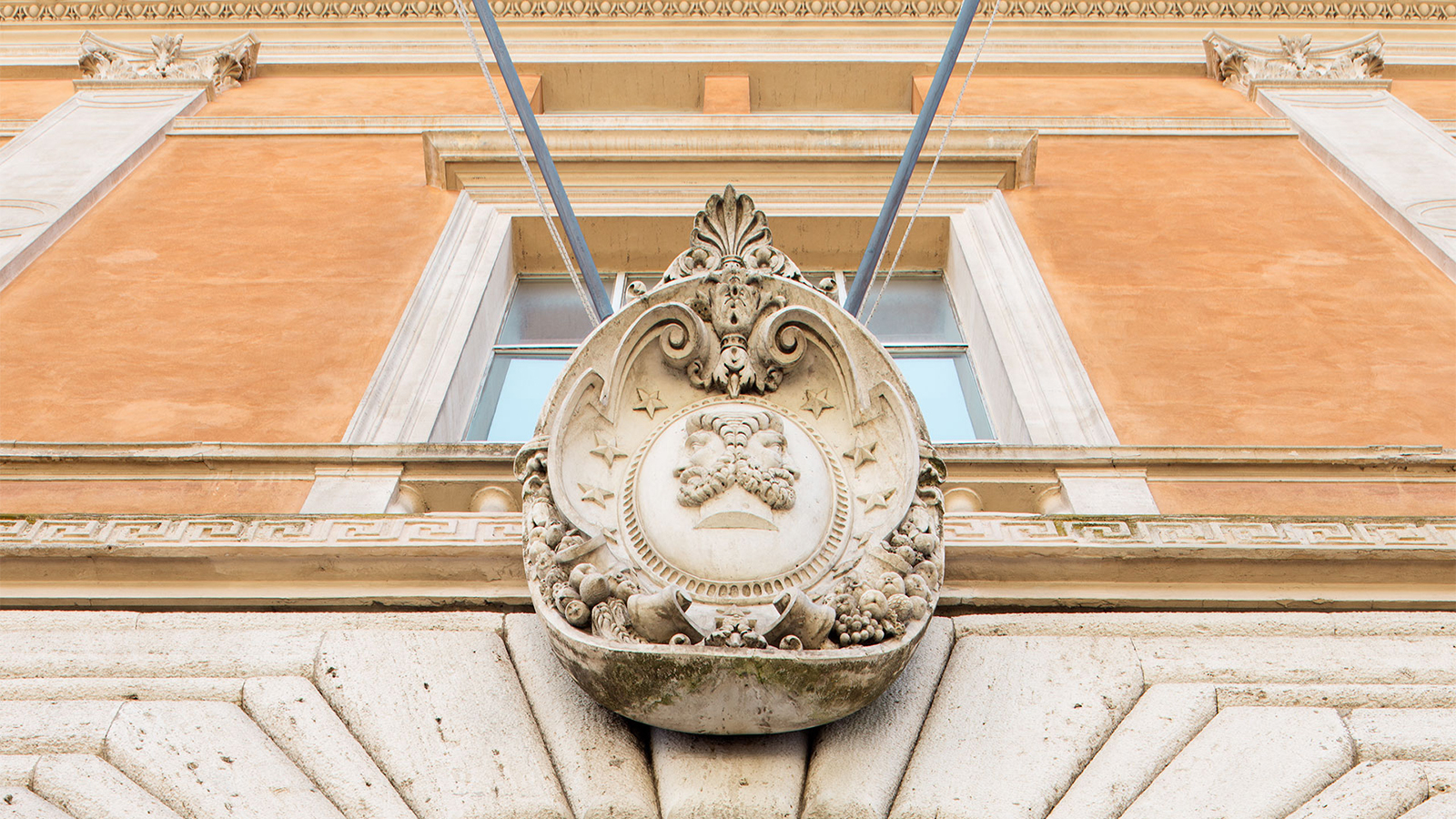
Janus above the front door of the American Academy in Rome’s Mckim Mead & White Building (photograph by altrospazio)
But AAR changed me . . . As one creates, it seems the process is intuitive among visual arts, but for my practice, intuition is not consciously there, and that means adjustment . . . My practice uses planning and time realization, it is very much edited long before it is executed, and that’s not the case from my experience of what to produce during a residency at AAR . . . Suddenly, time and Rome changed and sped up, pushing, coaxing new things out of me that I’m still feeling . . . New ways of working, even making work at the last minute, moments before the Uber ride to the airport, and even now at an elevation of 5280 in Colorado I’m still thinking about those 1200 hundred meters in Rome. These moments and works in-between fast and slow, and adjustments made me a better artist. I hope what I imparted at AAR was resonant, in slowness through adjustment in speed.
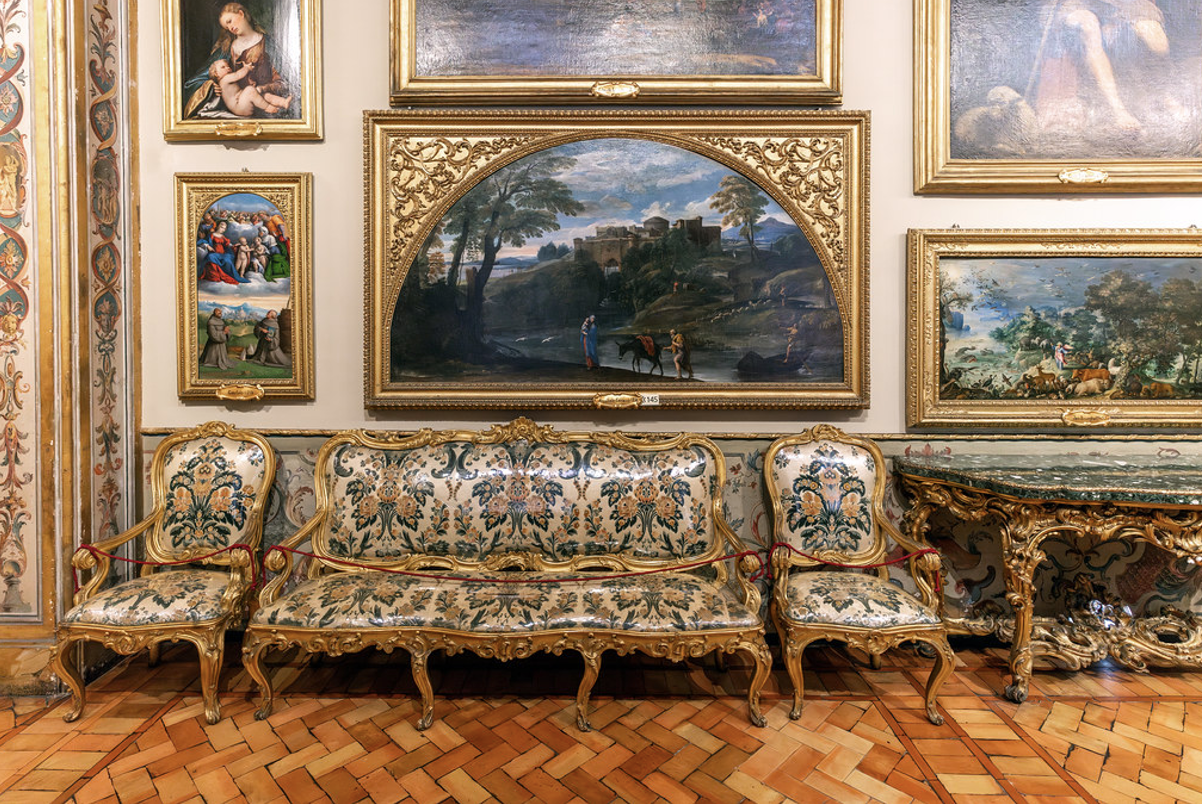
Doria Pamphilj Gallery
Share. Which is always been my inclination. But share in the most personal way . . . somehow in the end that’s the most meaningful. Doria Pamphilj Gallery . . . it’s where the Carracci masterpiece Flight into Egypt is housed, and that is my supposed inspiration . . . But on that foggy day, when I visit that old friend, in the grey loneliness of a treasure of a museum, or conversely in the blazing heat while the slow dark treasure seeps out . . . Either way it’s good to recognize those treasures within treasures . . . And that’s what the Academy epitomizes at its best. Look left and right . . . Sinistra . . . Destra . . . Janus.
Hayley Richardson
Denver, Colorado
2025